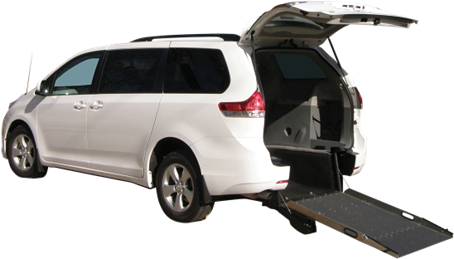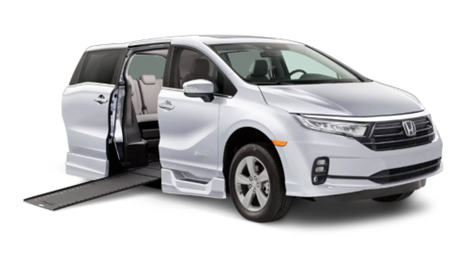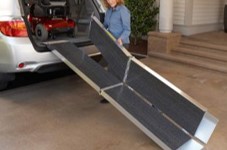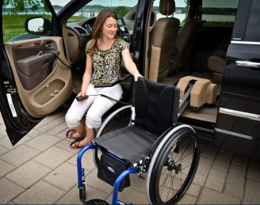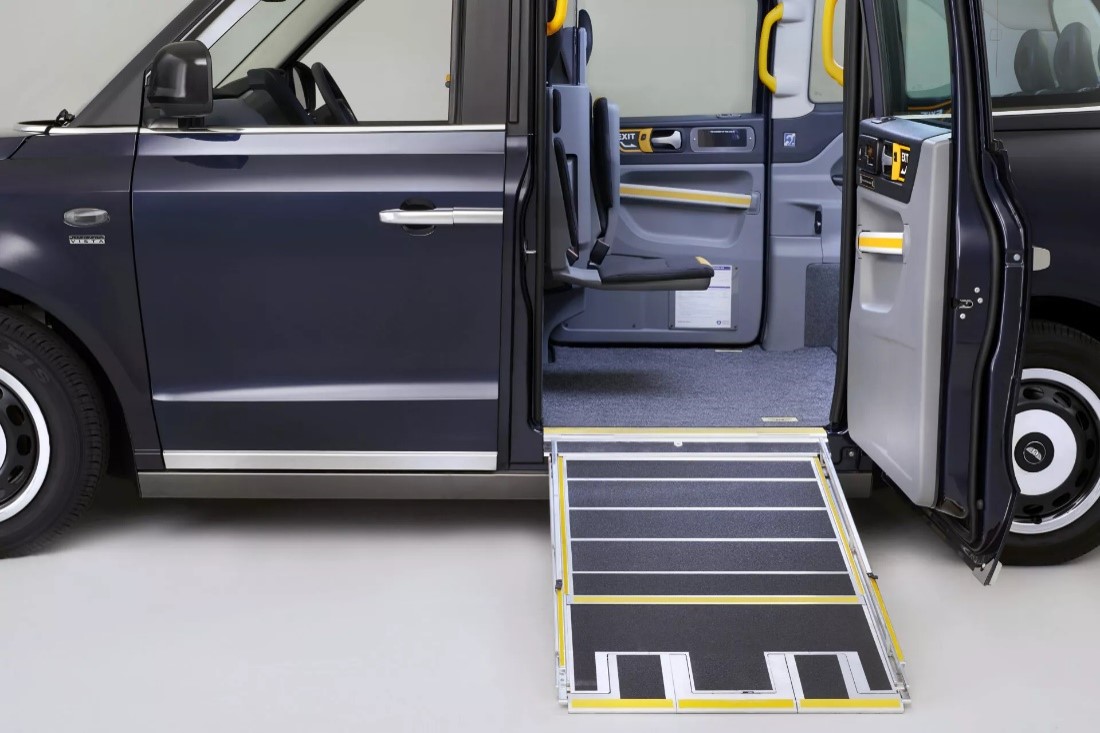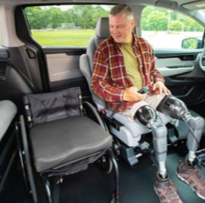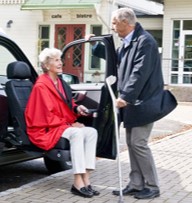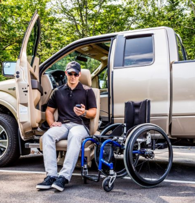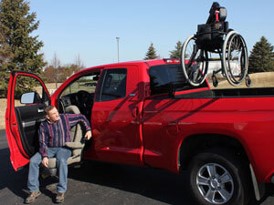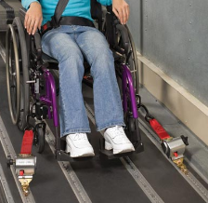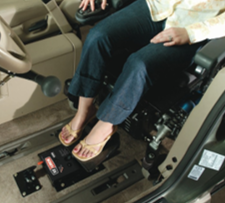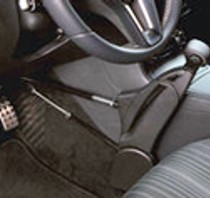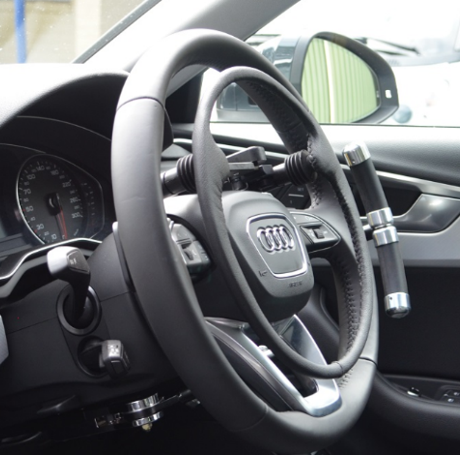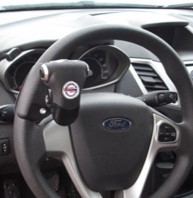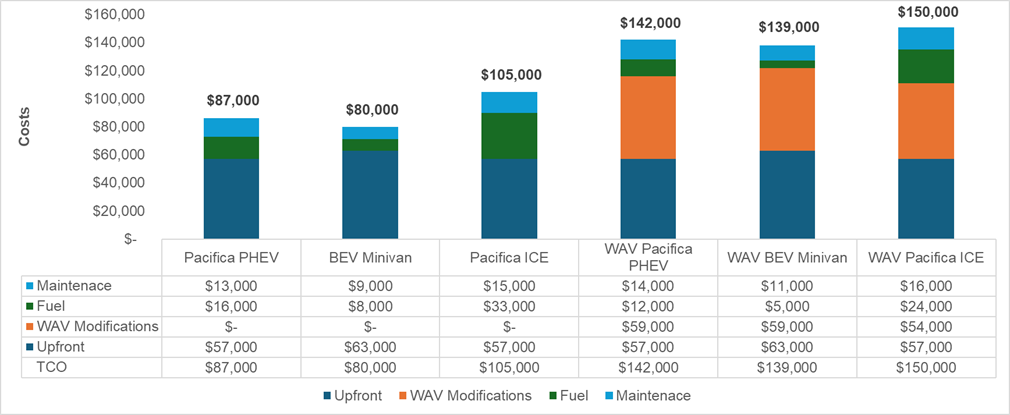Prepared by Left Turn Right Turn Ltd., for Transport Canada
April 2024
T42-36/2025E-PDF
ISBN 978-0-660-76114-5
TP 15632E
TP 15632F
Table of Contents
- Glossary
- Summary
- Thematic Findings
- Detailed Findings by Activity
- Literature Review: Travel Patterns of People with Disabilities
- Literature Review: Types of Vehicles Accessible and Modifications
- Jurisdictional Scan: Policies and/or Programs to Overcome Barriers to Accessible ZEVs
- Stakeholder Interviews
- ZEV Inventory Available for People with Disabilities
- TCO of ZEVs for People with Disabilities
- Policy Implications and Recommendations
- Appendix 1: Interview Questions
- Appendix 2: TCO Analysis Assumptions
Glossary
| Term | Definition |
|---|---|
| Battery Electric Vehicle (BEV) | Vehicles that run solely on electricity stored in a battery pack and produce zero tailpipe emissions. A BEV is a type of EV and ZEV. |
| Electric Vehicle (EV) | BEVs and PHEVs. |
| Gross Vehicle Weight Rating (GVWR) | The maximum allowable weight of the vehicle when fully loaded, including the vehicle, passengers, and cargo. |
| Internal Combustion Engine (ICE) Vehicle | A fuel-combusting vehicle. |
| National Mobility Equipment Dealers Association (NMEDA) | National industry association representing vehicle modifiers for accessibility. |
| Original Equipment Manufacturer (OEM) | Company that manufactures vehicles. |
| People with disabilities | According to the Accessible Canada Act: “A person with any impairment, including a physical, mental, intellectual, cognitive, learning, communication or sensory impairment — or a functional limitation — whether permanent, temporary or episodic in nature, or evident or not, that, in interaction with a barrier, hinders a person’s full and equal participation in society.” |
| Plug-In Hybrid Electric Vehicle (PHEV) | A vehicle that uses batteries to power an electric motor as well as another fuel in an internal combustion engine. Unlike conventional hybrid vehicles, a PHEV can be charged by a wall outlet or charger, not just from regenerative braking. A PHEV is a type of EV and ZEV. |
| Quality Assurance Program (QAP) | An accreditation program governing vehicle manufacturers to ensure their safety, quality, and reliability. |
| Return on Investment (ROI) | The benefit of an investment divided by its cost, expressed as a percentage. Used to compare investment options. |
| Total Cost of Ownership (TCO) | The total cost of an asset including its purchase cost and operating cost over its lifespan. In the case of vehicles, includes the purchase price, maintenance, and fuel. |
| Wheelchair Accessible Vehicle (WAV) | Vehicles that enable a driver or passenger to enter and ride/ drive while in their wheelchair. |
| Zero Emission Vehicle (ZEV) | A vehicle that either produces no tailpipe emissions or has the potential to produce no emissions. Includes BEVs, PHEVs, and fuel cell electric vehicles. |
Assessing the Accessibility of Affordable Zero-Emission Vehicles for People with Disabilities: Draft Study Report
Summary
Background and Objectives
To meet Canada's climate objectives, it will be necessary to reduce greenhouse gas (GHG) emissions from the transportation sector. Strategies to do this include increasing the share of zero emission vehicles (ZEVs) on roads. The Government of Canada is taking a comprehensive, whole-of-government approach focusing on addressing key barriers and opportunities to support the transition to ZEVs. This includes making ZEVs more affordable and available, deploying charging and hydrogen stations, building Canadian confidence in these clean vehicles, and seizing economic opportunities associated with these cleaner vehicles.
In March 2023, the Government of Canada launched a new ZEV Council aimed at bringing together key voices to identify, discuss, and work on solutions to further accelerate the transition to ZEVs. These parties include federal, provincial, and territorial governments, industry, and non-government organizations. The ZEV Council identified a key data gap in understanding the travel patterns and needs of people with disabilities; the unique barriers to accessing ZEVs; and the impact of these barriers to the Total Cost of Ownership (TCO) for ZEVs for people with disabilities. These barriers are situated within the broader context of the mobility patterns, needs, and challenges of the disability community.
This study sought to close these data gaps. In particular, the study:
- Describes the travel patterns of people with disabilities.
- Delineates the types of vehicles, including ZEVs, accessible for people with disabilities and/or modifications that people with disabilities require or use.
- Quantifies the costs and impact to TCO of those accessibility considerations and/ or modifications.
- Provides an inventory of the currently available ZEVs for people with disabilities in North America.
- Outlines other jurisdictions’ examples of policies and/or programs to reduce unique costs and improve accessibility of ZEVs.
- Reviews the interaction that accessibility of ZEVs might have with Transport Canada programs aimed at encouraging increased adoption of ZEVs.
The sections below present these findings.
Methodology
Throughout the study, we looked for information on considerations relevant to people with any disability. This includes people with cognitive differences, speech disabilities, people who are deaf/Deaf/hard of hearing, dexterity disabilities, physical/mobility disabilities, and mental health disabilities. However, as we anticipated, the bulk of the relevant considerations (the most common and the most significant barriers) related to dexterity, physical, and/or mobility disabilities.
With limited vehicles available on the market that can be modified for wheelchair users, this part of the literature review looked at both accessibility needs and modifications made to vehicles generally (both ZEVs and non-ZEVs). We used this information to identify barriers and challenges in the ZEV market for people with disabilities.
We completed this study through a literature review, interviews with key informants, and analysis of TCO. Each is outlined below.
Literature Review
We conducted a literature review to identify the types of accessibility considerations when selecting vehicles, including key features and possible modifications needed. We relied on both formal and informal literature such as standards and policy on modified vehicles, literature by people with disabilities and disability organizations, and information by vehicle modifiers, manufacturers, and their associations.
A secondary literature review sought to determine whether the daily/weekly travel patterns of people with disabilities are distinct from the daily/weekly travel patterns of people without disabilities. The goal of this research was to evaluate the frequency, distance, mode, and purpose of travel of persons with disabilities compared to persons without disabilities. Sources of travel pattern data investigated included published reports/studies, government reports, research papers and other relevant online resources that highlighted national travel patterns for a daily/weekly context.
Jurisdictional Scan
We conducted a jurisdictional scan to identify policies and/or programs in Canada and abroad aimed at addressing the barriers that people with disabilities face to accessing ZEVs. The barriers are identified through a literature review and interviews with organizations representing people with disabilities, as well as vehicle modifiers. As the literature review and interviews took place in parallel to this task, we conducted the scan based on our initial hypotheses of barriers faced, which are:
- Financial barriers:
- Pre-existing financial barriers for people with disabilities to purchase vehicles and modifications. For wheelchair accessible vehicles (WAVs), modifications can often cost as much as the vehicle itself.
- Financial barriers to accessing ZEVs. While ZEV purchase prices are approaching those of internal combustion engine (ICE) vehicles, they are still somewhat more expensive on an up-front basis.
- Availability barriers
- The main models that can be adapted to become WAVs are minivans. Minivan models are becoming rarer as automakers focus more heavily on producing sports utility vehicles (SUVs) and crossovers.
- There are currently no light-duty ZEVs available in the Canadian market that can be easily modified to be wheelchair accessible. The only ZEV minivan available currently is the Chrysler Pacifica plug-in hybrid electric vehicle (PHEV). However, the modifiers we interviewed indicated that it is difficult or impossible to modify to be wheelchair accessible because of the presence and size of the battery in the floor. This study was not able to verify whether the Pacifica PHEV can be modified, although we did find online sources indicating that some modifiers have successfully modified it.Footnote 1
- Accessibility barriers: There is a lack of accessible public electric vehicle (EV) chargers for people that use a wheelchair and with other disabilities, and no existing design standards in Canada to ensure accessibility.
In our scan, we looked for programs or policies that address these barriers. We conducted a jurisdictional scan through secondary research, using information available on the Internet. This approach allowed us to identify programs in place that aim to remove barriers encountered by individuals with disabilities in accessing ZEVs.
Stakeholder Interviews
We identified national organizations that represent people with disabilities, vehicle modifiers, and original equipment manufacturers (OEMs) to interview to inform the study. The table below outlines the organizations interviewed, their mission and relevant programs, and any other relevant information:
| Organization Interviewed | Mission/ Role | Why selected |
|---|---|---|
| Council of Canadians with Disabilities (CCD) | The leading national cross-disability advocacy organization. CCD unites provincial and disability-specific advocacy organizations to promote inclusion and disability rights in Canada. | To get a cross-disability perspective. CCD are also often focused on transportation accessibility, poverty alleviation, and disability-related supports. |
| March of Dimes Canada | A national charity striving “to be Canada’s leading service provider, resource and advocate, empowering people with disabilities to live and thrive in communities nationwide.” | Administers the Home and Vehicle Modification Program in Ontario that grants funding to people with disabilities for vehicle modifications. |
| Spinal Cord Injury Canada (SCIC) | A national charity striving to “assist people living with spinal cord injuries, or a related physical disability, to achieve independence, self-reliance, and full community participation. | SCIC has a program that offers peer support as people adapt to a spinal cord injury. Their Ontario branch has developed information and resources on vehicle modifications. |
| Canadian Association of the Deaf (CAD) | This national organization advocates for and represents the Deaf and “provides consultation and information on Deaf needs and interests.” | To validate whether there are any unique considerations for people with non-physical disabilities. |
| Little People of Canada | A national advocacy and fellowship organization aimed at supporting people of short stature. | To learn about different vehicle modifications. |
| Universal Motion | A private company that modifies vehicles, resells and rents accessible vehicles, and services accessible vehicles | To understand common vehicle modifications, costs, their ecosystem, and concerns about ZEVs. |
| Spark Access | A private firm with a mission to improve accessibility and disability inclusion across the mobility industry for people with disabilities. | Founder and Lead Consultant previously worked at General Motors as an Accessibility Strategy Manager. |
| National Mobility Equipment Dealers Association (NMEDA) | Non-profit that advocates and exemplifies excellence in providing safe, reliable transportation solutions to enhance accessibility. | Certifying body for Quality Assurance Program accreditation for vehicle modification, provides education and training, advocates for issues with legislators, has relationships with OEMs. |
| Global Automakers of Canada | National trade association representing automakers. | To understand the drivers and ecosystem of manufacturing modifiable vehicles. |
| Natural Resources Canada | Federal government department supporting the ZEV transition. | To understand the current state of the development of accessibility standards or guidance for charging infrastructure. |
Analysis
We leveraged insights from interviews to identify ZEV makes and models that align with the requirements of Canadians with disabilities, supplementing this with Dunsky’s inventory of ZEV models currently available at Canadian dealerships.
Our analysis identified the TCO for individuals with disabilities opting for ZEVs, with a particular focus on WAVs since they are the most expensive and most logistically difficult to undertake. We identified additional costs that people with disabilities (and/or their families/drivers) would be expected to incur for ZE WAVs, including upfront capital costs associated with modifications and subsequent maintenance costs related to these modifications. By establishing a comparison with the TCO of an unmodified ZEV and ICE vehicle and that of an ICE WAV, we quantified the effects through metrics such as payback period, return on investment (ROI), and cost per kilometer. Our TCO estimates reflect the typical usage patterns of individuals with disabilities in Canada identified in an earlier stage of this study.
Draft Report and ZEV Council Presentation
Following completion of these activities, we delivered a report with draft findings. Following preliminary feedback from Transport Canada, we presented the findings to the ZEV Council and facilitated discussion. We had over 50 attendees from federal departments as well as provinces, industry, and non-governmental organizations. This discussion informed the final report presented herein.
Thematic Findings
This section outlines thematic findings across all study activities. The findings of each activity are outlined in the section that follows.
Impacted Canadians with Disabilities and Modifications Needed
The 2022 Canadian Survey on Disability from Statistics Canada shows that 27% of Canadians aged 15 years and older have one or more disabilities.Footnote 2 This includes pain-related disabilities, mobility, mental health, hearing, seeing and developmental disabilities as shown by Table 2 below.
| Disability Type | % in 2022 |
|---|---|
| Pain-related | 61.8 |
| Flexibility | 40.3 |
| Mobility | 39.2 |
| Mental health-related | 38.6 |
| Seeing | 27.4 |
| Learning | 20.7 |
| Hearing | 20.7 |
| Dexterity | 18.4 |
| Memory | 18.2 |
| Developmental | 5.7 |
| Unknown | 2.8 |
Statistics Canada reports that of 2.2 million persons with disabilities who used federally regulated transportation in 2019 and 2020, 63% faced a barrier.Footnote 3 However, this data does not capture barriers in private vehicle transportation or vehicle modifications. Most people with disabilities do not require any modifications to personal vehicles to make them accessible.
Many different modifications are possible to meet the needs of different people with disabilities. However, most are relatively low cost (a few thousand) while modifications to make a vehicle wheelchair accessible are significant and costly. As a result, research or policy analysis on the accessibility of ZEVs should focus on the sub-set of people with disabilities that may require vehicle modifications for whom the charging infrastructure poses barriers (i.e. wheelchair users, people with dexterity or mobility disabilities).
The literature shows that people with disabilities travel slightly less than people without disabilities, in terms of time spent travelling, distance covered, and frequency of travel. This discrepancy may be linked to inequitable access to suitable transportation services rather than less desire or need for travel by persons with disabilities.
Barriers to ZEV Availability
Minivans are the most common type of vehicle modified to be a WAV, in large part because their design allows for the floor to be lowered enough to meet clearance requirements. The only ZEV minivan available currently is the Chrysler Pacifica PHEV, but it is not easily modified to be made wheelchair accessible. The Toyota Sienna conventional hybrid model is also commonly modified, but because it is not a ZEV it is not eligible for Transport Canada purchase incentive programs. Automakers have not made clear announcements or commitments to produce other ZEV minivan models.
This issue is compounded by the overall decline in minivan volume; in 2022, minivans only accounted for about 1.5% of Canada’s market, down from 8.8% 15 years prior.Footnote 4 Modifiers and others from the automotive sector who were interviewed highlighted the decline in market share and the fact that manufacturers are focusing their research and development, advertising, and ZEV transition in other segments. We were not made aware of any anticipated BEV minivan models. While the interviewees did not express concerns that there would be a complete end to minivan production in the future, they did point to some of the challenges with the current situation. For example, since ZEV minivans are new and relatively uncommon, there is a gap in knowledge among modifiers about how to work with them, resulting in a cost premium for ZEV modifications and further barriers to ZEVs for people with disabilities.
Unfortunately, the lack of attention to the need to produce modifiable (or fully accessible by design) vehicles means that many manufacturers are missing a sizeable–and growing–market opportunity. Canada’s population is aging; TD Canada projected that people with disabilities will comprise roughly a quarter of the working age population by 2040.Footnote 5 While not all of these people will require WAVs, many will, thus increasing the demand not only for accessible personal vehicles, but also for accessible services (e.g. taxis, airport services, medical transport, community transport).
Meanwhile, the regulatory environment will also result in significant growth in the demand for electric wheelchair-accessible vehicles. First, there will be stricter requirements in Canada for services to be accessible, thanks in part to the Accessible Canada Act, 2019, which is working toward a barrier-free Canada by 2040. Second, the federal government’s commitment to 100% ZEV sales by 2035 for all new light-duty vehicles means that personal vehicles and fleets must transition over the coming decades.
These regulatory forces are also playing out at the local level; for example, major cities including Toronto and New York are moving to require taxi and ride hailing fleets to be accessible and electric (see the Jurisdictional Scan section on page 33). Toronto’s taxi and ride hailing fleet comprises approximately 60,000 vehicles.
In all, this situation highlights a significant market opportunity and a need for further engagement with OEMs (incumbent and startups) to showcase the demand for accessible vehicles and the potential market opportunities they represent.
Barriers to ZEV Affordability
There are significant financial barriers to many people with disabilities accessing ZEVs for personal transportation, regardless of their need for vehicle modifications. Factors contributing to these barriers include:
- Lack of access to capital for people with disabilities:
- Statistics Canada has documented the pay gap between people with disabilities and those without. In 2019, people with disabilities earned an annual average income of approximately $11,500 less than people without disabilities ($43,400 compared to $55,200).Footnote 6 This is a 21.4% pay gap.
- Disability support and social assistance programs have not kept pace with the cost of living in Canadian jurisdictions.
- A few Canadian jurisdictions offer funding for individuals to acquire accessible transportation, but these are typically capped at $10,000 to $15,000 (see the Jurisdictional Scan section on page 33).
- Interviewees reported that most financial institutions are reluctant to finance the purchase or modification of vehicles; or only do so at high-risk interest rates. Note that there are some speciality loan programs on the market. Footnote 7
- High cost of WAV modifications:
- Our research showed that aftermarket WAV modification costs range from $42,000 to $65,000, easily doubling the purchase price of a vehicle and making them prohibitively expensive for many households (see Modification Marketplace section on page 46).
- The incremental upfront cost of ZEVs:
- A premium of roughly 10% (approximately $5,000) on the cost of WAV modifications is anticipated for ZEVs, given the lack of familiarity among modifiers.
Our TCO analysis for ZE WAVs (TCO Analysis section on page 51) confirms significantly higher costs than their non-modified counterparts, largely driven by modification expenses. For instance, the lifetime cost of a WAV Pacifica PHEV is estimated at $142,000, compared to $87,000 for a non-modified Pacifica PHEV. Similarly, the cost per kilometer for WAVs is more than double that of regular vehicles across all fuel types.
Additionally, our findings regarding the return on investment (ROI) and payback period of a ZEV further highlight the less favorable cost of ownership for WAVs. The average ROI for a ZE WAV ranges between 7% to 9%, significantly lower than the 31% to 39% for non-modified ZEVs, with correspondingly longer payback periods of about 10 years compared to 0 to 3 years for non-modified ZEVs. This discrepancy stems both from the modification costs and WAVs’ reduced fuel and maintenance savings compared to non-modified ZEVs, due to the shorter distances they travel over their lifetime. Nonetheless, the payback period for a ZE WAV is still less than its typical lifetime (20 years)Footnote 8, suggesting that a ZE WAV is still a feasible investment if a household can get access to the necessary upfront capital.
Charging Infrastructure Accessibility
In both the stakeholder interviews and the literature review, the accessibility of charging infrastructure emerged as a significant factor influencing the uptake of ZEVs in the disability community. This reflects United Kingdom (UK) research findings from 2021 where only 25% of people with disabilities surveyed would consider buying an EV, which increased to 61% if the charging infrastructure were more accessible.Footnote 9
Barriers to accessibility of the infrastructure, whether real or perceived, were brought up in all the interviews. Some of the specific barriers mentioned include, but were not limited to the following:
- Charging stations installed without curb cuts;
- Bollards and curbs blocking the charging station;
- The width and accessibility of the parking space;
- Digital display and payment area position on the charger itself;
- Exclusivity of cashless payment options;
- The ease of removing and replacing the charging cable and plug, including its weight;
- The tripping hazard and wheelchair navigation difficulties with charging cables on the ground;
- The lack of standardization in charging ports;
- Perception of vulnerability or a lack of safety while waiting for vehicles to charge;
- Placement of charging spots in relation to other vehicles; and
- The height of cables.
A recent report published by the Canadian Standards Association (CSA) in 2022, echoed the barriers highlighted in the stakeholder interviews. It was noted that, overall, EV charging infrastructure in Canada has not been built with accessibility in mind. The CSA report reads:
“There are growing concerns that existing public EV charging infrastructure in Canada and elsewhere has been built in a way that is not universally accessible.
This is particularly true for people who use mobility devices such as wheelchairs – charging points are often not installed at grade… or in parking spaces that use gravel, which makes it difficult, if not impossible, to navigate in a wheelchair. Furthermore, the parking spaces may not have a sufficiently wide allowance for a driver with reduced mobility to get in and out of the vehicle as well as access the charging point. Charging cables tend to be quite heavy – particularly for fast charging points – and can sometimes be installed too high to be reached. There are also accessibility concerns regarding the placement of screens and payment devices at charging stations, as well as problems with visibility and signage.”Footnote 10
The concern about accessibility compounds the well-documented range anxiety for drivers of EVs. A UK study from 2020 found that “range anxiety” can be further increased in disabled people when considering the many practicalities behind people’s lived experiences.”Footnote 11
The Canadian Standards Association, the British Columbia Institute of Technology, and Natural Resources Canada have been collaborating on an initiative to improve technical specifications and to adapt the US Access Board standards to a Canadian context. This effort includes researching similar documents and standards from other countries such as the United Kingdom and Ireland and developing technical specifications/design recommendations for EV charging infrastructure. This work is expected to result in a draft document in September 2024.
Internationally, other jurisdictions, such as the United States (US), Australia, and the UK, are incorporating accessibility requirements into technical assistance documents regarding charging infrastructure.Footnote 12 In Canada, Hydro Quebec includes guidance on accessibility in its Technical Installation Guide. Similarly, BC Hydro has started retrofitting stations and incorporating accessibility into future requirements.Footnote 13 Such requirements for accessible charging infrastructure researched included:
- Accessible user interfaces for chargers with or without screens including speech output (USA, required under the ADA)
- Clear floor or ground space at the same level as the vehicle charging space and positioned for unobstructed side reach (USA, required under the ADA)
- Vehicle charging space at least 11 feet wide and 20 feet long (USA)
- Paved access routes and lowered chargers (BC)
- Wider protective bollards (BC)
- Winter use locations must be cleared and accessible during winter and not be used as a snow dump or hinder snow clearing operations (QC)
More recently, a handful of municipalities have created or implemented changes to their requirements for EV charging infrastructure to make them more accessible. The City of Delta (British Columbia (BC)) recently engaged a third-party consultant to update the design standards for charging stations as it received grant funding to install additional chargers across the city. Improvements to the design of Delta’s charging infrastructure include:
- Shorter pedestals with lower handles and screens (minimum of one at each new site);
- Installation of new pedestals at pavement level, rather than on sidewalks or curbs, for easier handle reach;
- Installation of longer charging cables for the DC fast charge station;
- Inclusion of one parking stall at each charger site with wider dimensions;
- Implementation of a cable management system, eliminating the need for manual cable rolling; and
- Most new public stations will be on flat, paved surfaces, except for one location on a flat, gravelled surface.Footnote 14 (It is not clear why this one location is gravelled).
Other municipalities are also exploring how existing transportation standards around accessibility can be adapted to include accessibility considerations for EV charging infrastructure. These initiatives are led by municipal council members or advisory committees with personal interest in improving accessibility. While this shift in attitude is welcomed, significant gaps remain.
Detailed Findings by Activity
This section summarizes findings by each of the major project activities.
Literature Review: Travel Patterns of People with Disabilities
While several insights were gained through the literature review, there exist several gaps in this research. These gaps were addressed through key informant interviews.
Overall, it can be concluded that within Canadian, American, and international contexts, people with disabilities travel slightly less than people without disabilities, in terms of time spent travelling, distance covered and frequency of travel. This discrepancy may be linked to inequitable access to suitable transportation services rather than less desire or need for travel by persons with disabilities. Future exploration can be done into underlying causes for these trends.
Canadian Literature
A major finding from 2015 data from Statistics Canada was that people with disabilities (77.6%) had substantially lower rates of participation in transportation as compared to people without disabilities (83.1%).Footnote 15 This data does not distinguish by disability type. Differences could have resulted from inequitable access to certain kinds of transport for persons with disabilities and potential difficulty in using certain modes, according to Human Resources and Skills Development Canada.Footnote 16
Key informant interviews validated these findings. Disability organizations reported anecdotally that people with disabilities travel less than people without disabilities. They attributed this discrepancy to barriers to travel, such as accessible taxi options, and the cost implications of private vehicle ownership. One vehicle modifier noted that in their experience, modified vehicles are driven, on average, half the kilometers per year as unmodified vehicles. He attributed this discrepancy to the high cost of some vehicle modifications and the need to prolong the vehicle’s lifespan.
Assessed across different modes, persons with disabilities also had lower rates of participation in private vehicle transport (passenger or driver) and active transport (walking or cycling) with rates of 66.1% and 11.9% respectively, when compared to persons without disabilities (rates of 71.8% and 13.5% respectively).Footnote 17
A 2013 analysis by the Canadian Urban Transit Association (CUTA) highlights an increase in trip frequency/distance of trips by specialized transit distinct from an increase in the number of registered users.Footnote 18 The moderate growth of registrants from 237,479 to 312,967 over the eight-year period from 2004 to 2012, was limited in comparison to the increase in total distance travelled from 55,753,517 km to 86,714,141 km over the same period. While focused on specialized transit ridership, this is also a measure of travel patterns and frequency/distance. While this data does not distinguish between disability types, most specialized transit riders have mobility disabilities.Footnote 19
Another mode frequently used by persons with disabilities is accessible taxi services. According to a 2024 study in Toronto, Canada, there was a decline in the number of people with disabilities using accessible taxi trips but an increase in the number of health-related trips during the pandemic.Footnote 20 The study suggests that people with disabilities who continued/started using accessible taxi services during the pandemic are more likely to be among a socially disadvantaged group. A 2023 study on accessible taxi use found that the main trip purpose for people with disabilities is home-based health-related services (riders travelling from home to health services and vice versa).Footnote 21 Aside from acknowledging the representation of different disability categories in Canada, this study did not distinguish among types of disabilities.
International Literature
The overall similarities in trends between the US and Canada explored previously hints that gaps in Canadian data can potentially be explored through data from the US, keeping in mind that there may be significant variation in numerical statistics. Such observations may need further support/research, as can be done through later interviews with national disability organizations.
According to a 2022 study of over 116 previous studies on daily travel behaviour across different countries, persons with disabilities make 10-30% fewer trips than persons without disabilities, which is consistent with data specific to Canada.Footnote 22 This data included persons with mobility, cognitive and sensory disabilities, but did not distinguish among the types. Additionally, there is a trend of increased use of public transit, taxis and ride-hailing with others and decreased walking and driving among those with disabilities as compared to those without. In general, people with disabilities tend to use slower means of transportation and travel shorter distances than persons without on a global level. These findings can provide useful context for Canadian transportation decision-making for accessible transportation.
A 2019 publication in the Canadian Journal of Disability Studies compared time budgets for people with and without disabilities in Canada and the US.Footnote 23 Time budget studies collect data on how much time is spent on different activities in a specified period of time by different segments of the population. In minutes, people with disabilities and people without disabilities have time budgets for travel of 60.5 and 76.9 respectively in Canada. In the US, these time budgets for travel in minutes for people with and without disabilities are 46.8 and 73.6 respectively. These statistics show variation between the two countries, but the trend in persons with disabilities having less travel time budget remains consistent (with the figures for people with disabilities in the US being much lower as compared to persons with disabilities in Canada and persons without disabilities in both countries). This data does not distinguish between disability types.
A 2018 publication from the U.S. Department of Transportation (DOT) analyzed the travel patterns for “people with disabilities, referring to people who self-reported as having travel-limiting disabilities, such as using canes (36.7%), walkers (22.9%), wheelchairs or scooters (19.9%), crutches (2.6%), and white canes or guide dogs (2.4%). The data did not further distinguish between disability types.
The study found that regardless of age or working status, people with disabilities make fewer trips per day on average than people without disabilities, and these rates have declined over time.Footnote 24 People with disabilities also travel by personal vehicles (drivers or passengers) for fewer trips than do people without disabilities (74.8% vs. 83.8% of trips respectively). People with disabilities also travel as passengers for a larger share of personal vehicle trips than those without disabilities (38.9% vs. 16.1%). In addition to these discrepancies, over one-fifth (22.5%) of non-workers with disabilities and 12.2% of workers with disabilities live in households with no vehicles, whereas only 9.5% of non-workers and 3.9% of non-workers without disabilities live in zero-vehicle households. The study does not explore reasons for the decline over time.
Furthermore, trip purpose varies for people with and without disabilities. People aged 18 to 64 years with disabilities and people 65 years and older with disabilities take fewer trips than those without disabilities for work, social and recreational purposes, but not for shopping/errand trips or medical and dental trips. Distance travelled also varies for persons with and without disabilities. Workers with and without disabilities had averages of 9.4 and 12.0 miles travelled respectively, while non-workers had averages of 7.5 and 9.5 miles respectively for persons with and without disabilities.
Further analysis was provided by a 2022 study on rideshare use among people with disabilities.Footnote 25 More persons without disabilities utilized rideshare trips than did persons with disabilities (10.5% vs. 3.5%). However, people with disabilities who have used rideshare at least once, take more trips on average than riders without disabilities (5.8 vs. 4.4 trips). This study distinguished between people with a disability who don’t use a mobility device, blind/low-vision people, wheelchair users, and ambulatory people with disabilities. Blind or low-vision respondents were the highest rideshare user group among people with disabilities (7.1%). People who use wheelchairs utilized rideshare the least.
Addressing Gaps in Existing Research
The existing research presents several limitations. While trends were noted for travel patterns related to mode, frequency, distance, and purpose of travel, there is much room for more concrete, in-depth analysis of travel patterns of people with disabilities versus people without disabilities, and the underlying causes behind any difference in these patterns.
Literature Review: Types of Vehicles Accessible and Modifications
According to NMEDA, there are three key types of adaptive vehicle equipment:
- Lifts and ramps
- Seating and securement
- Alternative controls.Footnote 26
Each is described in greater detail below.
Most modifications are possible with nearly all vehicles. For example, pedal extenders can be added to all vehicles. Some modifications, however, can only be applied on certain vehicles. For example, installing hand controls requires information from the OEM to support appropriate installation. Wheelchair ramps and occupied lifts typically cannot be added into sedans because they do not have adequate space. Instead, SUVs and minivans are utilized for ramps and unoccupied lifts; full-size commercial vans (e.g. Mercedes Sprinter; Ford Transit) are necessary for occupied lifts.Footnote 27
The battery location makes wheelchair accessible conversion of light-duty ZEVs very difficult or impossible (see the Thematic Findings section, on page 9, and Stakeholder Interviews section, on page 43, for more details). Our reporting and analysis focused on light-duty vehicles used as personal vehicles and for taxi and ride-hailing services. There are medium-duty vehicle models, such as the Ford Transit and Mercedes-Benz Sprinter that are electric and wheelchair accessible. We have not focused on the medium-duty segment because most households are not willing or able to purchase these larger, more expensive vehicles, but they are good candidate vehicles for community transportation services.
Wheelchair Accessible Vehicle (WAV) Modifications: Lifts and Ramps
Vehicles purchased by mobility device users who require a lift or ramp must typically feature a lowered floor, larger interior cabin space, and/or larger door opening. Options for after-market modification depend on whether the size requirements of the adaptive equipment needed are compatible with vehicle specifications, which means wheelchair users often need to plan to purchase larger vehicles.Footnote 28
Lifts and ramps are the most significant and costly modification, as they typically require that the floor of the vehicle is lowered to ensure adequate head clearance while seated upright in a wheelchair or other mobility device. Vehicles can become wheelchair accessible with a ramp or lift. Ramps and lifts can be side or rear entry; in-floor or folding; and manual, motorized, or portable.
Rear entry ramp modifications (whether motorized or manual) can be made to either SUVs or minivans and typically involve less expensive conversions than side entry vans. Because the ramp deploys from the rear, they can be deployed in narrow parking spaces or garages. They are typically utilized for passengers, not drivers, that are transported in their wheelchair in the rear of the vehicle.Footnote 29 However, cargo storage is sacrificed for the ramp.
Description
A white van with a rear entry fold-out ramp
Description
A white van with a side entry ramp
Description
A woman folding a portable ramp at a rear entry van. Photos from wheelchairvans.ca, and mobilityworks.com, and 1800wheelchair.ca.
Side entry ramp modifications (whether motorized or manual) can only be made to minivans. They enable a wheelchair user to enter the vehicle and drive or ride as a passenger in the front or rear. Cargo space is maintained, but parking spaces must be wider to enable the ramp deployment and access.
Regardless of whether rear or side entry, in-floor powered ramps are stowed in the floor of the vehicle, maximizing space and maneuverability as well as more interior space. Fold-out ramps can be either power or manual and are stored either upright in the doorway or on the floor of a vehicle. Motorized ramps enable greater independence and convenience as they can be deployed without physical exertion. A manual ramp is less expensive but requires much more effort to extend and retract the ramp. Manual ramps require less maintenance and are seen as more reliable to some people with disabilities. Portable ramps are the least expensive and easiest to install. These ramps can be used with multiple vehicles and be removed whenever they are not needed.Footnote 30 However, they typically do not enable the same autonomy and can pose a greater risk to safety of the individual and the mobility device.
A lift is a piece of equipment that is either housed within or attached to a vehicle. It is designed to elevate a manual or power wheelchair or mobility scooter up and into the vehicle. Occupied lifts are intended to provide access into the vehicle for a person while remaining seated in their wheelchair. Unoccupied lifts are intended to enable transport of a mobility device after a person has transferred into the seats of the vehicle and out of the mobility device. Lifts rely on the vehicle’s battery to function and may be hydraulic lifts, electrical mechanical lifts, a gravity lift, platform lift, or a swing.
Description
A lift is raising a manual wheelchair into the vehicle.
Description
A full-sized van with a side entry lift. Photos from braunability.com, and adaptsolutions.ca.
While not ramps or lifts, our interviews also highlighted the need for entry aids. People of shorter stature may require mounted steps, lowered handholds, or ladders to enable access into the vehicle.
Wheelchair-accessible modifications to ZEVs present significant design challenges because the batteries are located in the floor of the vehicle that would normally be lowered. Batteries in plug-in hybrid electric vehicle (PHEV) models are smaller; some, like the Chrysler Pacifica PHEV, have been modified to be wheelchair accessible using a rear-entry design.Footnote 31 The LEVC TX,Footnote 32 manufactured by British OEM of commercial vehicles London EV Company, is a purpose-designed passenger PHEV that is compliant with London, UK’s taxi regulations. The TX comes with a standard Wheelchair Accessibility Package for side-entry that does not require additional floor lowering (see image 6 below).Footnote 33 We were unable to find examples of any fully battery electric vehicles (BEVs) with lowered floors nor initiatives seeking to engineer a solution. Interviewees indicated that solving this challenge will pose a significant engineering challenge due to the size and placement of the battery.
Description
TX Wheelchair Accessible Package van. Photo from levc.com.
Seating and Securement
This category of modifications supports an individual to transfer more easily or independently into or out of the vehicle, to sit safely in a driver or passenger seat, or to ensure that a person seated in a wheelchair is safely secured in the vehicle while it is in motion.
Adaptive seating can be placed in any position in the vehicle, either as a driver or passenger. In many vehicles the adaptive seating can be removed and reinstalled in a different vehicle or in a different position in the same vehicle, allowing someone to be a driver at some points and a passenger at others. Some adaptive seats utilize the original seating, maintaining the interior appearance of the vehicle.
Transfer seats are one type of adaptive seating. An interior transfer seat base is installed utilizing the original vehicle seat. It is motorized and has controls that allow the user to move it up/down, forward/back, and swivel in/out. An exterior transfer seat rotates out and over the door sill. With a button, the user lowers the seat to their preferred height, allowing them to transfer into or out of the seat. Transfer seats do not require structural modifications.
Description
An interior transfer seat.
Description
Exterior transfer seats.
Description
Exterior transfer seats. Photos from ecomedical.ca, mobilityworks.com, and adaptsolutions.com.
Transfer seats may be utilized alongside exterior securements, such as automatic car-top carriers, bumper-mounted carriers, hitch-mounted carriers, and pickup truck carriers. To ensure the balance of a vehicle is maintained, exterior securements cannot be added to all vehicles.
Description
An SUV with a scooter hoist is transporting the device using the vehicle’s hitch.
Description
A truck wheelchair lift placing a wheelchair in the truck’s bed. Photos from mobilityworks.ca.
Other seat adjustments may be used by people with smaller bodies (e.g. little people/ people with dwarfism).Footnote 34 They may need pedal extenders (see Alternative Controls section below) and other seating adjustments. For example, some people prefer a raised floor, like a footrest, so that their feet are not hanging over the pedals. Others may need thick back and seat cushions to provide appropriate sightlines, the ability to reach the steering wheel safely, and comfort.
Wheelchair securements ensure that a wheelchair is safely secured while the vehicle is in motion. They can be manual or retractable tie downs or docking systems and can be placed in the driver or passenger positions.Footnote 35Manual tie downs typically require assistance to ensure the wheelchair is properly secured and they cannot be utilized in the driver position. Retractable tie downs are electronic systems for people who cannot fasten the manual system. There is typically one device mounted on the bottom of the vehicle and another on the bottom of the wheelchair. When connected, a click signals that the wheelchair is properly secured. Docking systems are intended to easily secure a wheelchair to the floor of the vehicle, enabling someone to drive from the wheelchair. Different systems are used if the wheelchair is occupied or unoccupied while the vehicle is in motion.
Description
Manual tiedowns.
Description
A docking system. Photos from braunability.com.
Alternative Controls
Driving controls are devices that allow a person with a physical limitation to operate the driving functions of their vehicle.Footnote 36 Primary driving controls allow the driver to operate the vehicle, whereas secondary driving controls affect the non-steering and braking features, such as the horn and headlights.
Hand controls, a type of primary driving controls, are intended to enable someone to brake and accelerate with their hands instead of with their feet. The most common types use levers mounted under the steering wheel and attached to the pedals, whether push/pull, push/twist, push/right angle, and push/rock.Footnote 37 Other primary driving controls include:
- Steering ring accelerators, which are electronic rings installed around the steering wheel and allow braking and acceleration with two hands on the steering wheel
- Handgrips (such as spinner knobs), which assist someone with limited hand dexterity to grip the steering wheel
- Left-foot accelerator pads
- Servo-assisted hand controls, which are a customizable joy-stick style driving alternative.
Most of these adjustments are relatively straightforward and enable people to drive the vehicle with either the pedals or the hand controls.
Description
Hand controls
Description
An accelerator ring.
Description
A handgrip. Images from: mobilitybasics.ca, pmeautoconversions.com.au, and mobilityworks.com.
People relying on hand controls may also install pedal guards to ensure that the foot pedals are not unintentionally pressed. Pedal extenders are another type of primary driving control that enable drivers to reach the pedals. They attach to the pedals.
Secondary driving controls address non-steering/braking features such as the horn, headlights, turn signals, wipers, heating, etc. These controls can involve use of a toggle switch, touch pad, headrest switch, elbow switch, and voice control. The choice of most appropriate control depends on the drivers’ physical capabilities.
Visual and vibrating alert systems notify deaf or hard of hearing drivers of important vehicle alerts, such as turn signals and proximity alerts, through lights and/or vibrations. As most vehicle auditory alerts are provided in a visual format (e.g. blinking lights), these modifications are less common and less critical. However, they are more accessible when in the driver’s line of sight, such as on the windshield or dashboard.
Newer versions of these systems also utilize artificial intelligence to interpret sound outside of the vehicle, such as horns honking or sirens, and will notify the driver.Footnote 38 One interviewee noted that because ZEVs do not make the same vibrations that ICE vehicles do, deaf and hard of hearing people may not know that the vehicle is not off. Automatic shut-off functions or external notification lights (e.g. flashing headlights) are useful to notify the driver of a forgotten item (e.g. child, key) or process (e.g. lights).
OnStar TTY Equipment may also be required for deaf or hard of hearing people.Footnote 39
Summary of Vehicle Modifications
Table 3 below summarizes the categories of vehicle modifications that we have learned about and their approximate costs.
| Modification | Summary description | Cost estimateFootnote 40, Footnote 41 |
|---|---|---|
| Low floor modification | Lowers the floor of the vehicle to make it easier for a ramp to be deployed and allow additional headroom for a person in a wheelchair. | $35,000 - $50,000 |
| Wheelchair lifts | Helps to elevate a wheelchair or scooter in and out of the vehicle. Alternatively, lifts/secures a mobility device for transport. | $1,700 - $20,000 |
| Wheelchair ramps | Enables no-step access of a mobility device into the vehicle. | $6,000 - $10,000 |
| Adaptive seating | Facilitates entry and exit of the user into the seat and/or into the vehicle. Also ensures comfort and safe sightlines. | $6,000 - $14,000 |
| Wheelchair securement | Methods of securing the mobility device in the vehicle, including manual tie downs, retractable tie downs, and docking systems. | $1,000 - $5,000 |
| Hand controls | Enable hand accelerating and braking. Also support hand control for people with limited dexterity or hand strength. | $2,000 - $4,000 |
| Foot controls | Extended or alternative foot controls. | $500 - $2,000 |
| Visual and vibrating alerts | Systems to convert car alerts or external sounds into visual or vibrating alerts. | $200 - $4,000 |
Jurisdictional Scan: Policies and/or Programs to Overcome Barriers to Accessible ZEVs
Addressing Financial Barriers
Most programs identified in the scan focus on financial barriers to vehicle modifications, with limited specific emphasis on ZEVs. Notable exceptions include two initiatives in Greece and the UK. In Greece, an additional €1,000 ($1,450 CAD) subsidy is provided for people with disabilities on top of an existing EV subsidy offered. In the UK, the Motability Scheme (funded by a private foundation) allows individuals with a qualifying mobility allowance from the government to exchange their allowance to lease modified vehicles or EVs. However, advance payments are often required for modified ZEVs obtained through the Motability Scheme due to the higher base cost and the complexity of modifications, particularly with ensuring the battery does not interfere with the lowered floor of WAVs. Individuals in financial need can apply for grants to cover the advance payments. More information is in table 4 below.
Across the US, there are several public programs that aim to help those with disabilities overcome barriers to owning a vehicle. Notably, the 21st Century Assistive Technology (AT) Act (AT Act) provides funding to 56 states and territories for AT activities (including vehicle modifications). Each state or territory with funding from the AT Act has its own program with these activities and more. Additionally, most OEMs in North America offer reimbursements of up to $1,000 for vehicle modifications made to new vehicles (including ZEVs) purchased or leased through eligible dealers.
In Canada, there is a patchwork of public and private programs that cover some costs associated with obtaining accessible vehicles or modifying vehicles for accessibility. Quebec’s funding programs were cited by an interviewee as being the most supportive; there are programs that cover the cost of modifications and their maintenance available through the province’s public auto insurance regime.
Further, under Quebec’s tax exemption, people with disabilities are exempt from paying provincial sales taxes (TVQ) on the purchase or rental of modified vehicles, on the portion of the cost that applies to the modification.Footnote 42 Qualifying modifications are those that allow wheelchair access or facilitate operation of the vehicle, and on services related to those modifications. Federal tax exemptions are provided under the Excise Tax Act following a parallel approach, and also apply to provinces participating in the Harmonised Sales Tax regime.Footnote 43 In Ontario, the Home and Vehicle Modification program provides funding up to $15,000 to individuals for vehicle modifications every 10 years.
The federal “medical expenses” non-refundable tax credit is available to individuals (or the family member claiming the expenses) that make vehicle modifications due to a disability. Qualifying expenses include “power-operated lift or transportation equipment” to allow “the patient in gaining access to a vehicle or to place the patient’s wheelchair in or on a vehicle”; and devices “to enable a patient with a mobility impairment to operate a vehicle.” Footnote 44 As a non-refundable tax credit, it is only beneficial to families that earn enough taxable income. As one policy paper noted, “Designing the support as a tax credit means that only those Canadians with disability who earn enough income to have them owing taxes can take advantage of it. Yet it is an unfortunate reality that people with disability are often at low incomes precisely because their disability leaves them unable to work in full-time, well-paid jobs.”Footnote 45
Finally, charitable organizations in Ontario, B.C. and Alberta that help youth with disabilities have available funding for mobility, which includes vehicle modifications. See table 4 below for further details about these programs.
We found no specific programs in North America addressing the additional costs faced by individuals with disabilities when accessing ZEVs. There are, of course, various existing subsidy programs in Canada that aim to address the higher upfront cost of ZEVs, including rebates in B.C., Quebec, Nova Scotia, New Brunswick, P.E.I., Newfoundland and Labrador, Northwest Territories, and Yukon. However, these programs do not provide additional subsidies for individuals with disabilities; their primary objective is to encourage EV adoption across the board.
Addressing Availability Barriers
We did not find major initiatives in North America aimed at increasing the supply of accessible or easily modifiable vehicles. However, many OEMs currently offer rebates to customers who have purchased a new vehicle who invest in modifications; for example, GM provides customers up to $1,500 on eligible vehicles when customers add eligible accessibility-related equipment.Footnote 46 GM has an Accessibility Center of Excellence.Footnote 47 This initiative aims to create barrier-free mobility offerings, with stated plans to develop new products, particularly focusing on aligning the EV transition with more accessible vehicles. However, outside of GM’s efforts, there are limited programs advocating for increasing the availability of purpose-built or easily modifiable ZEV models.
People with disabilities also use taxis and ride-hailing services for their transportation needs. They face several pre-existing barriers to accessing these services, including a lack of wheelchair-accessible vehicles in the fleet, and being turned down for service by some drivers. Some city-level regulatory efforts have required these fleets to offer a minimum number of accessible vehicles or pay a fee to help supply them. In recent years, these requirements have been interacting in different ways with cities’ regulations requiring these fleets to electrify. In London, UK, the municipal transport agencies require taxis to be both wheelchair accessible and at least partially electric. In Toronto, in contrast, regulations requiring taxi and ride-hailing fleet electrification have so far explicitly exempted accessible vehicles, citing a lack of available models that are both electric and accessible. New York City took a similar approach in its regulations, requiring taxi and ride-hailing vehicles to be zero-emissions or accessible by 2030.
A handful of initiatives have sought to design and manufacture purpose-built WAVs rather than relying on aftermarket modifications. The discontinued MV-1 is a North American example (although an ICE vehicle) and the LEVC-TX is a ZE WAV being used in taxi fleets in the UK and elsewhere. Please see Table 4 below for further details.
Summary of Policy and Program Examples
| Location | Public or private program | Program details | Comments |
|---|---|---|---|
| Greece | Public |
Greece’s “I move electrically” EV subsidy program provides subsidies on the purchase of electric vehicles ranging from €2,000-€8,000 ($2,900 - $11,600 CAD) depending on the vehicle type.Footnote 48 People with disabilities are eligible for an additional €1,000 ($1,450) subsidy. |
Main program goal to address financial barrier of ZEVs. Recognizes additional costs to people with disabilities, but not at a level that matches typical modification costs. |
| UK | Private |
The Motability Scheme allows people with a qualifying mobility allowance (i.e. disability living allowances) to exchange it for a car lease, WAV lease, or modifications. Footnote 49 It includes regular servicing, insurance and breakdown cover, and ongoing support from staff. If customer chooses a ZEV, Motability will arrange and cover the cost of a home charging station and standard installation; if customer does not have off-street parking, Motability gives access to the bp pulse network of public charging stations. |
Main program goal to address financial barrier of accessing AT and vehicles. No additional consideration for ZEVs (but does cover cost of charging installation at home or give access to public charging stations). |
| UK | Private | The Motability Foundation offers various grants for those that wish to participate in the Motability Scheme but do not have the funds to pay for the advance payment or modifications needed. |
Main program goal to address financial barrier of accessing AT. No additional consideration for ZEVs. |
| US | Public | US Department of Veterans Affairs provides a one-time payment to help buy a specially equipped vehicle (up to $25,600 USD) and in some situations one or more adaptive-equipment grants.Footnote 50 | Main program goal to address financial barrier of accessing AT. No additional consideration for ZEVs. |
| US | Public | The 21st Century Assistive Technology Act, a new 2023 program, provides funding to 56 states and territories and mandates activities to ensure people with disabilities are informed about, have access to, and can obtain assistive technology (AT).Footnote 51 |
Main program goal to address financial barrier of accessing AT. No additional consideration for ZEVs. |
| California | Public |
Low-interest loans for AT that range from $500-$15,000 USD. Terms up to 5 years with a 6% fixed interest rate. Footnote 52 |
Main program goal to address financial barrier of accessing AT. No additional consideration for ZEVs |
| NY and NJ State | Public | Loan program through National Disability Institute that provides loans up to $45,000 USD for Assistive Technology, typically at a 4% interest rate.Footnote 53 |
Main program goal to address financial barrier of accessing AT. No additional consideration for ZEVs. |
| North America | Private | Various OEMs (e.g. Toyota, Subaru, Honda, Ford, Chrysler, Dodge, Jeep, etc.) offer reimbursements of up to $1,000 for vehicle modifications.Footnote 54Typically needs to be a new car purchased or leased through certified dealer. Includes new ZEVs. |
Main program goal to address financial barrier of accessing AT. No additional consideration for ZEVs. |
| Canada | Public | Vehicle modifications are an eligible medical expense for a non-refundable tax credit. Can only claim amounts not reimbursed. Footnote 55 |
Main program goal to address financial barrier of accessing AT. No additional consideration for ZEVs. |
| Canada | Public | Tax Relief for Specially Equipped Motor Vehicles: Individuals modifying vehicles can benefit from zero-rated equipment/services (no GST/HST) either directly from the supplier or through claiming it on their tax return. Footnote 56 |
Main program goal to address financial barrier of accessing AT. No additional consideration for ZEVs. |
| Quebec | Public |
Reimbursement for modified vehicle costs: Under the province’s public automobile insurance regime, people with disabilities from a motor vehicle accident can obtain grants to obtain a modified vehicle.Footnote 57 People with disabilities from other circumstances can access the Adapted Vehicles for People with Disabilities Program, which similarly provides coverage for modifications and maintenance of those modifications. Quebec also offers parallel tax exemptions to those offered federally. |
Main program goal to address financial barrier of accessing AT. No additional consideration for ZEVs. |
| Ontario | Public |
Funding up to $15,000 through the Ontario Home and Vehicle Modification program for vehicle modifications every 10 years.Footnote 58 Must be in financial need (combined household income of under $60,000). Administered by March of Dimes. |
Main program goal to address financial barrier of accessing AT. No additional consideration for ZEVs. |
| Ontario | Private | Equipment Funding Program through Easter Seals Ontario provides up to $3,000 per calendar year for children with disabilities under the age of 19 years, who don’t qualify for existing government programs/are financially at risk.Footnote 59 Children applying must already be registered as Easter Seals Ontario clients. |
Main program goal to address financial barrier of accessing AT. No additional consideration for ZEVs. |
| BC | Private |
Up to $5,000 annually for equipment including mobility for children under the age of 19 years, who don’t qualify for existing services provided by government.Footnote 60 Provided and administered by CKNW Kids’ Fund, a registered charity in BC. |
Main program goal to address financial barrier of accessing AT. No additional consideration for ZEVs. |
| Alberta | Private |
Up to $10,000 for people under the age of 21 available for mobility devices and other equipment/technology.Footnote 61 Provided and administered by Children’s Ability Fund, a registered charity in Alberta. Note the program is not currently accepting applications. |
Main program goal to address financial barrier of accessing AT. No additional consideration for ZEVs. |
| BC | Public | BC Hydro plans to make its entire EV charging network fully accessible.Footnote 62 This is being done through retrofitting old stations and building new sites that are barrier-free and meet the new accessibility guidelines, which require a minimum of 3.7 meters in width for accessible stalls.Footnote 63 | Main goal is to address the need for accessible public charging stations. |
| US | Public |
US Access Board released a technical assistance document to assist in design and construction of EV charging stations that are accessible to people with disabilities under the American with Disabilities Act (ADA) and Architectural Barriers Act (ABA).Footnote 64 Entities subject to the ADA and ABA must provide charging stations that are accessible (ex: state and local government offices, public parks, street parking, rest stops along Interstate Highway System). |
Main goal is to address the need for accessible public charging stations. |
| UK | Public | National British Standards Institution (BSI) created a ZEV accessible charging specification document which was co-sponsored by Motability and the UK Government.Footnote 65 | Main goal is to address the need for accessible public charging stations. |
| London, UK | Public |
Accessible taxi requirements: Transport for London (TfL), London’s municipal transport agency, requires 100% of taxis to be wheelchair accessible via regulation.Footnote 66 This requirement does not apply to ride-hailing vehicles; as a result, very few such vehicles are accessible. Low-emissions requirements: As of January 2023, TfL also requires all newly licenced taxis and ride-hailing vehicles.Footnote 67 to be zero-emissions capable (in other words, to be BEV, PHEV, or fuel cell electric vehicles). Existing vehicles must be re-licenced within ten years. The combination of accessible and low-emissions requirements for London’s considerable taxi fleet (nearly 20,000 vehicles in 2022).Footnote 68 has resulted in market innovation to produce compliant vehicles, including the LEVC TX.Footnote 69 These vehicles are now being used beyond the UK in cities like Cairo and Beijing.Footnote 70 |
Goals: to ensure that people who use wheelchairs can call and use any taxi in the City and to transition the taxi and ride-hailing fleets to zero- or low-emissions vehicles. Indirectly, the combination of regulations has also led to the production of accessible PHEV vehicles. |
| Toronto | Public | ZEV requirements for taxi and ride-hailing vehicles.Footnote 71 As of 2024, newly licenced taxis and ride-hailing vehicles must be ZEVs (BEV or fuel cell electric vehicles; PHEVs are permitted until 2032). However, accessible vehicles are exempt from the requirement.Footnote 72 Under the existing regulations for these vehicles, an “accessibility fee" is collected from drivers of non-accessible licenced vehicles to be distributed to drivers of accessible vehicles, recognizing the increased cost. | Goal: to transition the taxi and ride-hailing fleets to zero-emissions vehicles. The regulators considered accessibility but determined it was not reasonable to ask drivers to source accessible and electric models at this time. |
| North America | Private | In the mid-2000s, the Vehicle Production Group company was founded with the express purpose of designing and manufacturing a purpose-built WAV (ICE model), which eventually became the MV-1.Footnote 73 The initiative received private funding and a $50 million grant from the US Department of Energy. The company manufactured several thousand models in an Indiana-based assembly plant. Ultimately, the plant was purchased by investors and stopped producing the vehicles. | Goal: support the design and production of purpose-built WAVs. |
Stakeholder Interviews
The thematic findings of all interviews are reported here because of the similarity in themes across sources.
Travel Patterns of People with Disabilities
Anecdotally, interviewees generally agreed with the findings in the Literature Review on page 18 that people with disabilities travel slightly less frequently than people without disabilities. They attributed this to several factors, including societal barriers (e.g. inaccessibility of public transportation and taxi/ ride-hailing vehicles), financial barriers, and disability management (e.g. potentially reduced energy; or less energy available after completing other daily activities). However, travel patterns and mode of travel were reported to range depending on geography (e.g. urban versus rural), availability of alternative means of travel, income, disability type, and support system.
Perceptions and Concerns about ZEVs
Overwhelmingly, interviewees had little direct exposure to ZEVs, personally, professionally, or through relationships with others. As a result, they were unable to comment on any experiences of people modifying a ZEV.
They had significant concerns about ZEVs, some of which were unique to the experience of people with disabilities and others that are shared with people without disabilities. Some of these are broader societal challenges without simple solutions, whereas others may be challenges that can be addressed through policy and/or information.
Because of the income gap that people with disabilities experience, many interviewees viewed ZEVs as cost prohibitive.Footnote 74 See the section on Barriers to Affordability (see page 12) for further exploration of this income gap. Affordability is a greater barrier when vehicles require substantial modifications (e.g. WAVs), for new vehicles, and for vehicles perceived as being more costly, such as ZEVs. As one interviewee noted: “If I can’t even attain the oldest model how can I afford the newest model?”
Interviewees further identified significant concerns with the accessibility of public charging infrastructure. The issues identified included:
- Is the parking space accessible (e.g. near the destination; wide enough to deploy a side-entry ramp)?
- Is there a safe and accessible path of travel from the vehicle to the charging station (e.g. not in traffic, cut curbs)?
- Is the charging station accessible (e.g. not blocked by bollards or on a curbed boulevard)?
- Can the charging cables be managed with minimal dexterity, reach, arm strength, or one hand? Might charging cables block the accessible paths of travel?
- How will the accessibility of this infrastructure be impacted by weather and snow conditions?
- Are the communication features and user interfaces accessible? How high are they? Is there a non-audio output? How large is the text?
One interviewee was concerned about on-street urban charging that would require exiting the vehicle into traffic, travelling to the nearest intersection to find a curb cut, and then struggling to plug the cable in without rolling over the cable or falling into the street.
Further, people with disabilities are also more likely to live in rented dwellings than the general population (32.5% compared to 26.4%), posing barriers to the installation of home-based charging infrastructure.Footnote 75 One interviewee owned a ZEV, but had not installed home charging because of the cost and concerns as a renter (e.g. ability to make improvements; stability of housing). Without reliable and consistent accessibility in charging stations, people with physical disabilities cannot switch to ZEVs.
Charging infrastructure concerns were compounded by concerns about safety and user experience when charging, and the added vulnerability of people with disabilities if problems arose. For example, would a ramp to exit the vehicle deploy if the battery were fully discharged? Highlighting statistics on violence against people with disabilities, an interviewee questioned whether they be subjected to violence if stranded. The interviewee noted that this would be a concern in any environment but was an especially great concern in areas that were darker or more isolated. For example, a 2009 report concluded that the “rate of violent victimization, including sexual assault, robbery and physical assault, was 2 times higher for people with activity limitations than for people without activity limitations.”Footnote 76 This interviewee spoke about current challenges when trying to fill the vehicle with gas and their dependency on other drivers or the attendants. With unstaffed charging stations, they feared this would be an even greater challenge. The risk and fear of victimization is greater for women with disabilities, Indigenous and racialized people with disabilities, and Indigenous and racialized women with disabilities.
This theme in the interviews reflects a finding from a 2016 Transport for London study that gauged the interest of electric vehicles among seniors and people with disabilities. One of its key findings was that this audience is “acutely aware of, and sensitized to, anything going wrong and disrupting their experiences. As such, they are likely to manage any risks as much as they can… Anything that represents a risk for this audience is quickly discounted.”Footnote 77
One interviewee further noted barriers in information about ZEVs, which is key to addressing the previous concerns. They noted that traditional sources of information such as manufacturer websites, consumer reports, and owner’s manuals may be inaccessible to people who are Deaf and whose first language isn’t written English. This interviewee noted: “Communication barriers during the negotiating and purchase process for ZEVs … may give them less confidence in the vehicle buying process, which may make them reluctant to shop for and purchase a vehicle.” The vehicle shopping experience poses similar challenges.
Modification Marketplace
Interviewees with disabilities spoke about the additional challenges and complexities of shopping for modified vehicles or non-modified vehicles that would then be modified. They noted that:
- Non-modified vehicle salespeople are rarely knowledgeable about vehicles’ existing vehicle accessibility features, and whether they can be modified.
- There are often accessibility barriers in the process of purchasing a vehicle, for example not being able to test drive the vehicle because it is not modified.
- The primary challenges with modifications are financial and the limited vehicle options that are available for WAV conversion.
Interviewees were able to speak to which modifications are most common in their experience but could not offer reliable broader information about the most common modifications. For example, vehicle modifiers most frequently modify for wheelchair accessibility and other modifications by that same user (e.g. hand controls). However, they would often not be engaged for more straight-forward modifications such as hand controls that can be purchased online and installed by the consumer.
Most vehicle modifiers in North America are members of NMEDA, which administers the Quality Assurance Program (QAP), the only accreditation for vehicle modifier businesses in North America. The QAP ensures safety and provides a quality control manual, training for certified technicians, third-party audits, and inspections.Footnote 78 As part of the program, all modifications to new vehicles must be reviewed and accepted by the NMEDA, which includes undergoing crash testing and other applicable compliance tests.Footnote 79 Vocational rehabilitation agencies in 31 states and the province of Québec require that modifiers hold QAP accreditation.
There are several types of vehicle modifications made for people with disabilities with varying costs, the most time-intensive and costly being to create a WAV, which typically includes a low floor modification, wheelchair ramp or lift, and wheelchair securement. Modifiers interviewed noted that adaptions such as hand controls and foot controls are easily accessible to the customer, with no additional financial burden or availability barriers when it comes to ZEVs versus ICE vehicles. WAVs were thus the focus of our interviews with the vehicle modifiers, as they presented the greatest barriers, both financial and in terms of modification challenges.
Interviewees provided pricing sheets, price estimates, and price research that were used in the TCO analysis. See TCO Analysis section on page 51 for further details. WAV modifications were reported to vary from $42,000 to $65,000. It was noted during one interview that modification costs would likely be slightly more for ZEVs, because technicians are not familiar with those vehicles. This interviewee estimated that there would be at least a 10% markup on wheelchair modification costs on a ZEV in the near term.
In addition to the upfront modification costs, annual maintenance for the modified equipment typically ranges from $200 to $300, according to one interviewee. Another interviewee stated that proactive maintenance of modifications is rare, and that WAV owners more often seek maintenance only when components are broken. Anecdotally, most modifiers’ shops are located in more suburban/remote areas and not co-located with other auto maintenance shops, so there is an additional time burden for WAV owners to seek proactive maintenance.
The types of vehicles typically modified to become WAVs are minivans. One interviewee mentioned that the Chevy Traverse, a larger SUV model, has also been modified to be a WAV. Currently, the only ZEV minivan available in the North American market is the Chrysler Pacifica PHEV. Despite evidence that some Chrysler Pacifica PHEVs have been modified,Footnote 80 we were not able to verify from interviewees whether this is possible, with some interviewees citing that the battery in the Pacifica PHEV makes it impossible to modify. The Toyota Sienna hybrid was mentioned several times as a common WAV option, however, it is not considered a ZEV due to it being a traditional hybrid and not a PHEV.
| Vehicle | Fuel type |
|---|---|
| Toyota Sienna | Hybrid |
| Chrysler Pacifica | ICE and PHEV |
| Chrysler Grand Caravan | ICE |
| Honda Odyssey | ICE |
| Chevy Traverse | ICE |
Moreover, aside from the constraints of ZEV minivan availability, modifiers encounter several challenges with modifying them, including challenges with the size and placement of batteries, payload capacity, and lack of training and education on ZEVs. Table 6 summarizes these challenges.
| Challenges |
|---|
| Batteries |
| Large batteries make lowering the floor challenging. In traditional hybrid vehicles (e.g. Toyota Sienna) and some PHEVs, the battery is small enough that modifiers can relocate it and make room for a lowered floor. BEV batteries are larger and much more difficult to relocate. |
| ZEVs have no drill zones in the floor due to the battery location, and modifiers require alternative areas for drilling to install wheelchair securement systems. |
| Increased thickness of the vehicle floor due to the battery affects ramp deployment; the ramp must be able to be deployed at a prescribed angle to be safe. |
| Weight |
| ICE and ZEV versions of vehicle models typically have the same Gross Vehicle Weight Rating (GVWR) (the maximum weight a vehicle is designed to carry). Since the batteries in ZEVs add more weight, the remaining payload available in a ZEV is lower than for an ICE equivalent. This has implications for the number of modifications that can be made (particularly in the case of power wheelchair users, which are quite heavy) and the number of additional passengers and cargo the vehicle can safely accommodate (which is a particular challenge for families). |
| Training and education |
| Certified technician training at the NMEDA to modify ZEVs does not currently exist. |
| Dealers are unfamiliar with batteries and are hesitant to work on them, likely leading to longer modification times for ZEVs. |
Modifiers also highlighted that support from OEMs to address these concerns is currently limited. However, there is a strong desire amongst modifiers to increase collaboration and shared insights.
OEMs and Disability
We heard in our interviews that OEMs currently have upfit departments that work with vehicle modifiers. Under non-disclosure agreements, they can share vehicle designs so modifiers can plan modifications. Some OEMs also offer factory packages that are easier to modify that modifiers can choose from. However, several interviewees noted that this proactive relationship is relatively new and that the willingness to collaborate and share designs varies among OEMs. Several interviewees confirmed that shorter product development timelines for ZEVs are also shortening the amount of time that modifiers have to design and certify modifications for new vehicles, if they receive the specifications at all.
In the context of the ZEV transition, one interviewee pointed out that OEMs are more focused on increasing ZEV aerodynamics and lowering costs during the design stages, often overlooking accessibility considerations – especially in a context where there is more time pressure to get ZEVs to market and design timelines are compressed.Footnote 81 Consequently, design changes are creating limitations for accessible ZEVs, including:
- Roofs coming down for aerodynamics;
- Floors coming up to protect the battery; and
- Features such as grab handles removed for cost reasons, which some people with disabilities rely on for assistance with vehicle entry and exit, particularly self-transfers.
Several modifiers emphasized the need for increased consideration of accessibility in the early stages of vehicle designs. GM was cited as a leader, having established an Accessibility Center of ExcellenceFootnote 82, which has introduced initiatives such as incorporating a customer survey for people with disabilities, along with creating a panel of accessibility experts for feedback during the design stages. One interviewee also highlighted the need for more people with disabilities as design engineers and suggested that the implementation of disability employment obligations regulated by the government is one such way to increase consideration for accessibility. For instance, in France, any employer with greater than 20 employees is required to have 6% of their workforce comprised of people with disabilities. Failure to meet the quota results in payment to the state.Footnote 83
ZEV Inventory Available for People with Disabilities
Table 7 outlines the ZEV models that are compatible with the most common modifications for people with disabilities; this list was validated with interviewees. WAVs, typically characterized by features such as a lowered floor, manual or powered wheelchair ramp, and wheelchair securement, are most commonly built using minivans. The only ZEV minivan available in the market today is the Chrysler Pacifica PHEV; no fully electric WAVs are known to have been created. While there are other ZEV choices suitable for wheelchair lifts, they are largely medium-duty vans, which are typically not suitable for household ownership. Modifications like hand and foot controls, along with visual/vibrating alerts, are generally appliable across all vehicle models.
| Modification | ZEV models that can be modified |
|---|---|
| Low floor modification | Chrysler Pacifica PHEV |
| Wheelchair ramps | Chrysler Pacifica PHEV |
| Wheelchair securement | Chrysler Pacifica PHEV |
| Adaptive seating | Most ZEVs (some powered versions require a minivan) |
| Unoccupied wheelchair lifts | Chrysler Pacifica PHEV |
| Occupied wheelchair lifts | Medium-duty vehicles (ex: Ford e-Transit, Mercedes e-Sprinter) |
| Hand controls | Any ZEV |
| Foot controls | Any ZEV |
| Visual and vibrating alerts | Any ZEV |
TCO of ZEVs for People with Disabilities
Methodology and Assumptions
Table 8 provides a summary of the common minimum (least costly) and maximum (most costly) modifications involved in creating a WAV based on information provided by interviewees. Additional costs to add driver controls or adaptations for drivers who use a wheelchair are not included in the Table.
| Modification | Average cost |
|---|---|
| Example #1 - WAV modifications (lowest cost package) | |
| Low floor modification | $35k |
| Manual wheelchair ramp | $6k |
| Wheelchair securement (tie-downs) | $1k |
| Total | $42k |
| Example #2 - WAV modifications (highest cost package) | |
| Low floor modification | $50k |
| Powered wheelchair ramp | $10k |
| Wheelchair securement (docking system) | $5k |
| Total | $65k |
The TCO will vary from person to person depending on the specific modifications they need, their travel behaviour/needs, and the cost of fuel/electricity in their jurisdiction. For the purposes of this analysis, we focused on the modifications needed to create WAVs as they are the most significant modifications. This TCO sets the upper limit for modified vehicles, whereas the TCO for vehicles with more minor adaptions or modifications will fall between that of a fully modified WAV and a non-modified vehicle. Table 9 summarizes the vehicles included in our analysis and their associated upfront costs. They are further reviewed in Appendix 2. We made the following key assumptions regarding costs:
- A hypothetical battery electric vehicle (BEV) minivan was included in our analysis to estimate the TCO for a BEV option, despite the absence of such vehicle in the market currently.
- Modification costs represent the average of the minimum and maximum modification packages needed to convert a vehicle into a WAV.
- Based on insights from our interviews, WAV modification costs for ZEVs are assumed to be 10% higher than for ICE vehicles given the lack of familiarity of ZEVs in the modifier marketplace currently.
- The upfront vehicle costs listed are based on 2024 purchase prices. As ZEVs become more widely adopted in the coming years, we anticipate costs to approach those of ICE vehicles and reach cost parity.
- We discounted future costs to present-day values (2024) in our analysis, and thus all costs are expressed in real dollars.
- We incorporated the iZEV purchase rebate for ZEV models ($5,000 reduction in purchase price for the Chrysler Pacifica PHEV).
| Vehicle | Fuel type | Upfront vehicle costFootnote 86 | Modification costsFootnote 87 | Charging infrastructure costsFootnote 88 |
|---|---|---|---|---|
| Chrysler Pacifica | PHEV | $55,000Footnote 89 | $59,000 | $2,200 |
| General BEV Minivan | BEV | $61,000Footnote 90,Footnote 91 | $59,000 | $2,200 |
| Chrysler Pacifica | ICE | $57,000 | $54,000 | - |
For each vehicle model analyzed, both the regular and WAV version of the vehicle were considered. We assumed, based on information gathered in both the interviews and literature review, that people who own WAVs drive half the distance that average vehicle owners do annually.Footnote 92 Furthermore, the average lifespan of WAVs was assumed to be 20 years, compared to the 14 years typical of regular vehicles. We heard from our interviews that WAVs stay on the road much longer than non-modified vehicles because they are generally driven less, and they remain valuable longer because of the costly modifications.
| Type | Lifetime (years) | Annual distance (km) | Lifetime distance (km) |
|---|---|---|---|
| Regular vehicle | 14 | 14,700Footnote 93 | 206,000 |
| WAV | 20 | 7,400 | 147,000 |
Results and Discussion
TCO Comparison Between WAVs and Non-Modified ZEVs
The TCO refers to the total amount that a vehicle owner will spend over the vehicle’s lifetime on purchasing, maintaining, and fuelling the vehicle. As depicted in Figure 1, the TCO for WAVs is significantly higher than their equivalent non-modified vehicle across all fuel types, which is primarily due to the increased upfront costs associated with modifications. However, considering that WAVs and regular vehicles have differing lifespans and lifetime distance driven, an examination of the cost per kilometer offers a more nuanced and precise metric for comparison.
Figure 1 also demonstrates the business case for ZEVs in general, since in all cases the BEV and PHEV models have lower TCO than the ICE models.
Figure 1: Summary of TCO and costs by vehicle
Description
| Pacifica PHEV | BEV Minivan | Pacifica ICE | WAV Pacifica PHEV | WAV BEV Minivan | WAV Pacifica ICE | |
|---|---|---|---|---|---|---|
| Maintenance | $13,000 | $9,000 | $15,000 | $14,000 | $11,000 | $16,000 |
| Fuel | $16,000 | $8,000 | $33,000 | $12,000 | $5,000 | $24,000 |
| WAV Modifications | $- | $- | $- | $59,000 | $59,000 | $54,000 |
| Upfront | $57,000 | $63,000 | $57,000 | $57,000 | $63,000 | $57,000 |
| TCO | $87,000 | $80,000 | $105,000 | $142,000 | $139,000 | $150,000 |
From the cost per kilometer data shown in Table 11, we can see that a stark contrast exists between regular vehicles and WAVs. Regardless of the fuel type, WAVs have a cost per kilometer that is more than double that of their regular vehicle counterpart. This reaffirms that owning a WAV incurs substantially higher cost, and the significant financial implications that potential WAV owners must consider.
| Vehicle | Non-modified | WAV |
|---|---|---|
| Chrysler Pacifica PHEV | $0.42 | $0.96 |
| General BEV Minivan | $0.39 | $0.94 |
| Chrysler Pacifica ICE | $0.51 | $1.02 |
ROI and Payback of ZEVs (WAVs and Non-Modified Vehicles)
Table 12 summarizes the payback period and Return on Investment (ROI) of ZEVs in comparison to ICE vehicles. Given the TCO is lower for ZEVs compared to ICE vehicles (as seen in Figure 1), it logically follows that the ROI for both ZE WAVs and regular vehicles is positive. Additionally, the payback period for both is shorter than the assumed lifetime of the vehicles, which further highlights the financial benefits of opting for a ZEV.
However, WAVs demonstrate a significantly lower ROI and extended payback period in comparison to their regular vehicle counterparts. This discrepancy is due to the initial capital cost of the modifications, as well as WAVs’ reduced fuel and maintenance savings compared to regular ZEVs, which is a consequence of the shorter driving distances over their lifetime. These findings highlight a crucial point: people with disabilities may find the financial incentives to switch to a ZEV less compelling, given the longer payback period and lower ROI.
| Vehicle | Payback period | ROI | Incremental upfront costs | Fuel savings | Maintenance savings |
|---|---|---|---|---|---|
| Chrysler Pacifica PHEV | 0.0 | 31% | $530 | $17,000 | $1,600 |
| General BEV Minivan | 2.8 | 39% | $6,500 | $26,000 | $6,000 |
| WAV Chrysler Pacifica PHEV | 8.9 | 7% | $5,900 | $12,000 | $1,200 |
| WAV General BEV Minivan | 10.6 | 9% | $11,900 | $19,000 | $4,300 |
Policy Implications and Recommendations
Reviewing Transport Canada Rebate Programs to Address WAV TCO
The Canadian programs found in the Jurisdictional Scan section reveal that current programs aimed at assisting people with disabilities to access personal transportation, where they exist, address a portion of the upfront costs of vehicle modifications without specific considerations for ZEVs. These existing support mechanisms for modifications include federal and provincial sales tax exemptions, non-refundable tax credits, government grants, low-interest loans, grants from charitable organizations, and a $1,000 to $1,500 rebate provided by OEMs. With the average modification costs for WAVs ranging between $42,000 to $65,000, plus a premium for modifications to ZEVs, there is a clear need for enhanced financial support to help mitigate substantial barriers people with disabilities face in acquiring necessary modifications.
The existing federal iZEV rebate offers some relief by reducing the initial purchase price of ZEVs, yet it does not provide additional funding for people who need to modify their vehicle. At a minimum, the rebate program could be modified to address the additional 10% incremental cost of modifying a ZEV to be a WAV compared to modifying an ICE vehicle (about $5,000). This supplement could be integrated into the current iZEV rebate program, which would provide people needing a WAV with more reason to switch to a ZEV.
In addition to benefitting individuals who need a WAV, the presence of a WAV-specific ZEV rebate could spur the development of options on the accessible ZEV market, providing OEMs and modifiers alike with a greater incentive to develop products that would be eligible for the supplemental rebate.
Rebate program designers should also consider the current manufacturer suggested retail price limit for vehicle eligibility. Should the program ever be revised to cover used vehicles, the purchase price limit would need to be raised for WAVs to accommodate their higher value once modified.
Transport Canada also administers the iMHZEV rebate program for ZE medium- and heavy-duty vehicles. While we did not investigate this vehicle segment in this study, certain medium-duty vehicles (e.g. Ford Transit, Mercedes Sprinter) are important for accessible transportation services’ fleets and are available in ZEV models. Transportation services are an important part of the ecosystem: not all individuals can or want to own a personal vehicle. Therefore, having accessible, electric transportation service fleets is an important part of ensuring access to electric mobility for people with disabilities.
Transits and Sprinters are generally easier to modify to be wheelchair accessible because they are taller (and therefore have more clearance). Subject to further study, a similar approach to that mentioned above for light-duty vehicles (providing a supplemental rebate covering the incremental cost of modifying a ZEV compared to an ICE vehicle) could be appropriate for the iMHZEV program to help transportation services access accessible and electric vehicles. For those households that do need to acquire this type of vehicle to fit their family (e.g., multiple people that use wheelchairs), Transport Canada could also consider offering a rebate on a targeted basis.
Communication and Collaboration between OEMs and Modifiers
The limited availability of ZEV minivan options further increases barriers for people with disabilities seeking environmentally friendly WAVs. As mentioned in the ZEV Availability section on page 11, OEMs recognizing the broader market potential of WAVs and minivans is crucial. Two main opportunities exist.
Firstly, communication and collaboration between OEMs, modifiers, and users of modified vehicles needs to be improved. OEMs should be encouraged to collaborate with modifiers – specifically by providing new ZEV model specifications as early as possible. OEMs should also be encouraged to integrate accessibility considerations early in the ZEV design process. This is particularly important to address the current modification challenges with ZEVs, such as batteries hindering low floor modifications and vehicle weight restrictions, as highlighted in the Modification Marketplace section. Consider including NMEDA on the ZEV Council or identify other opportunities to build partnerships. Ensuring people with disabilities are employed within OEMs is an important piece of the puzzle: some jurisdictions require that companies receiving government funds employ a minimum number of people with disabilities.
Given the concerns about the declining focus on minivan models (typically the only kind of vehicle that can be modified), it will be important to track the availability of modifiable vehicles in general, and modifiable ZEVs specifically. Chrysler currently manufactures Pacifica minivans (including the PHEV model) in Windsor, ON; efforts could be made to ensure this production continues.
In parallel, exploring the development of a purpose-built ZE WAV presents another potential solution. As mentioned in the Jurisdictional Scan section on page 33, in London, the combination of accessible and low-emissions requirements for its taxi fleet has resulted in the creation of a purpose-built ZEV taxi that is fully wheelchair accessible. In North America, the MV-1 was a purpose-built WAV (ICE model) that initially received US government funding, but production has since ceased.
Efforts to advance this development could benefit from partnerships between the private sector, academia, and government-funded initiatives (such as the Ontario Vehicle Innovation Network). These collaborations could focus on assessing and showcasing the business case for a purpose-built ZE WAV, as well as helping companies with accessible vehicles outside North America (for example, the LEVC-TX) navigate domestic crash testing and other processes to get approved for sale in Canada.
Continue with Development of Infrastructure Accessibility Guidance
People with disabilities cannot use ZE WAVs unless the charging infrastructure is also accessible. To date, much of Canada’s infrastructure has been designed without people with disabilities (physical and non-physical disabilities) in mind. Particularly considering the Accessible Canada Act, Natural Resources Canada (with CSA) should continue helping Canada catch up to the US by developing standards for accessible charging stations. Natural Resources Canada could integrate accessible standards into its requirements for federally-funded charging stations via the Zero-Emissions Vehicle Infrastructure Program (ZEVIP). The government can then work with the Canadian Standards Association or another relevant national body to develop clear and implementable design standards.
Support for Municipal Regulators
As detailed in the Jurisdictional Scan section on page 33, large municipalities are leveraging their licencing power to require their taxi and ride-hailing (e.g. Uber and Lyft) fleets to electrify. Toronto is the first Canadian municipality to make this move, requiring all taxi and ride hailing vehicles to be ZEVs by 2030. However, Toronto (like New York City) exempted accessible vehicles from this requirement, since vehicles that could meet both standards do not yet exist in North America (in contrast to the UK and other jurisdictions, where purpose-built ZE WAVs have been produced to meet requirements).
As it works with industry to help secure appropriate models, the federal government should keep municipalities informed so regulators can adjust their rules accordingly and ensure people with disabilities have access to electric mobility at the same rate as Canadians at large.
Technician Training and Equipment
The federal government, with participation of provincial governments where possible, could play a leading role in funding the development of technician training on ZEV modifications to substantially narrow the knowledge gap that currently exists and thereby reduce the cost differential between ZE WAVs and ICE WAVs. In some cases, modifiers may need to acquire additional certification, equipment, or renovate their shops to accommodate modifications on vehicles with batteries. There should be government funding to catalyze these updates.
Further Study
The Literature Review on pages 18 to 32 determined that there is not robust and current Canadian data on the travel patterns of people with disabilities, on the most common vehicle modifications, and breakdowns by disability types. This provides opportunity for further study to inform future policy development.
Appendix 1: Interview Questions
National Disability Organizations
- We are aware of the following vehicle modifications/ accessibility considerations:
- Wheelchair lifts and ramps, including lowering floors/ raising ceilings (hoist)
- Adaptive seating, including interior or exterior transfer seat (swivel seats)
- Wheelchair securement, including manual tie downs, retractable tie downs, or docking systems.
- Hand controls for brake and gas pedals
- Foot controls, including pedal extensions and left food accelerator.
- Visual and vibrating alert systems
- What are the main characteristics that make a vehicle model more compatible/configurable with that key modification?
- What specific challenges do you anticipate/have you experienced when people are considering modifications to ZEVs?
- There isn’t a lot of current data on daily/ weekly household travel patterns. How would you say that the daily/ weekly travel patterns of people with disabilities the same or different as people without disabilities? For example, how often they travel; how far they travel; how they travel; the purpose of their travel?
- What has been the experience of people seeking to modify a ZEV and the current national ZEV funding programs (i.e. iZEV) or vehicle modification funding programs?
- The government is focusing on addressing key barriers and opportunities to support the transition to ZEVs. What barriers do you see for people with disabilities?
OEM and Modifier Interview Questions
- What are the main characteristics that make a vehicle model more compatible/configurable with modifications?
- What kinds of support do the OEMs provide to modifiers? What do you need from them?
- Are you aware of having provided modifications to ZEVs?
- What specific challenges do you anticipate/have you experienced when making or contemplating modifications to ZEVs?
- What are you hearing from customers with disabilities about challenges or needs around vehicle modifications?
- Are you able to supply us with cost estimates for modifications? Do you expect that it would cost more to apply this modification to a ZEV, compared to a gas vehicle?
Appendix 2: TCO Analysis Assumptions
A summary of additional assumptions made in the TCO analysis that are not covered within the TCO of ZEVs for People with Disabilities section is below.
- BEV/ICE split for the Chrysler Pacifica PHEV is assumed to be 50%/50%
- All costs are expressed in real dollars (future costs discounted to 2024 dollars).
- Tax is excluded from all calculations within this analysis, and potential tax exemptions for modifications are also excluded. We estimate that the inclusion of tax exemptions would not materially impact the TCO for WAVs.
- Grants, financing, or tax exemptions for vehicle modifications are not incorporated because they vary across the country, may be income tested, and the value of tax credits varies based on income.
| Vehicle | Fuel EfficiencyFootnote 94 | Vehicle Maintenance Costs ($/km)Footnote 95 | Modification Maintenance Costs ($/year)Footnote 96 |
|---|---|---|---|
| Chrysler Pacifica PHEV | 0.08 L/km (ICE) 0.26 kWh/km (BEV) |
0.06 | 250 |
| General BEV Minivan | 0.27 kWh/km | 0.04 | 250 |
| Chrysler Pacifica ICE | 0.11 L/km | 0.07 | 250 |
| Fuel | 2024 CostsFootnote 97 |
|---|---|
| Electricity | 0.16 $/kWh |
| Gasoline | 1.61 $/L |

